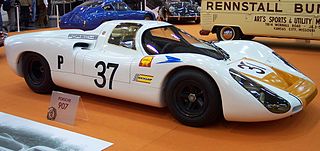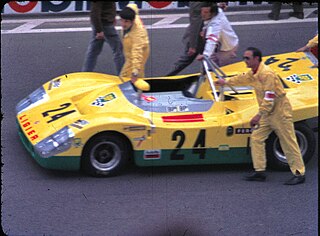
The Ford GT40 is a high-performance mid-engined racing car originally designed and built for and by the Ford Motor Company to compete in 1960s European endurance racing. Its specific impetus was to best Scuderia Ferrari, which had won the prestigious 24 Hours of Le Mans race for six years running from 1960 to 1965. Around 100 cars have been made, mostly as 289 cu in (4.7 L) V8-powered Mk Is, some sold to private teams or as road legal Mk III cars. Racing started in 1964, with Ford winning World Championships categories from 1966 to 1968. The first Le Mans win came in 1966 with three 427 cu in (7.0 L) powered Mk.II prototypes crossing the finish line together, the second in 1967 by a similarly powered highly modified US-built Mk.IV "J-car" prototype. In order to lower ever-higher race top speeds, a rule change from 1968 onwards limited prototypes to 3.0 litre Formula 1 engines; a loophole, however, allowed the private JW "Gulf Oil" team win at Le Mans in 1968 and 1969 running a Mk.I with a 5.0 litre engines.

The DFV is an internal combustion engine that was originally produced by Cosworth for Formula One motor racing. The name is an abbreviation of Double Four Valve, the engine being a V8 development of the earlier four-cylinder FVA, which had four valves per cylinder.

The Porsche 917 is a sports prototype race car developed by German manufacturer Porsche to exploit the regulations regarding the construction of 5-litre sports cars. Powered by a Type 912 flat-12 engine which was progressively enlarged from 4.5 to 5.0 litres, the 917 was introduced in 1969 and initially proved unwieldy on the race track but continuous development improved the handling and it went on to dominate sports-car racing in 1970 and 1971. In 1970 it gave Porsche its first overall win at the 24 Hours of Le Mans, a feat it would repeat in 1971. It would be chiefly responsible for Porsche winning the International Championship for Makes in 1970 and 1971. Porsche went on to develop the 917 for Can-Am racing, culminating in the twin-turbocharged 917/30 which was even more dominant in the role. Porsche drivers would win the Can-Am championship in 1972 and 1973. 917 drivers also won the Interserie championship every year from 1969 to 1975.
Michael Henderson Spence was a British racing driver from Surrey in England. He participated in 37 Formula One World Championship Grands Prix, debuting on 8 September 1963. He achieved one podium, and scored a total of 27 championship points. He also participated in numerous non-Championship Formula One races, as well as sports car racing.

Richard James David "Dickie" Attwood is a British motor racing driver from England. During his career he raced for the BRM, Lotus and Cooper Formula One teams. He competed in 17 World Championship Grands Prix, achieved one podium and scored a total of 11 championship points. He was also a successful sports car racing driver and won the 1970 24 Hours of Le Mans race, driving a Porsche 917, the first of Porsche's record 19 victories at the famous race.
The Ferrari P was a series of Italian sports prototype racing cars produced by Ferrari during the 1960s and early 1970s.

The Lotus 49 was a Formula One racing car designed by Colin Chapman and Maurice Philippe for the 1967 F1 season. It was designed around the Cosworth DFV engine that would power most of the Formula One grid through the 1970s. It was one of the first F1 cars to use a stressed member engine combined with a monocoque to reduce weight, with other teams adopting the concept after its success. An iteration of it, the 49B, also pioneered the use of aerofoils to generate downforce.

The Porsche 908 was a racing car from Porsche, introduced in 1968 to continue the Porsche 906-Porsche 910-Porsche 907 series of models designed by Helmuth Bott (chassis) and Hans Mezger (engine) under the leadership of racing chief Ferdinand Piëch.

The Porsche 907 is a sportscar racing prototype built by Porsche in 1967 and 1968.

The Mirage Lightweight Racing Car was a family of race cars built by J.W. Automotive Engineereing (JWAE) at Slough in England, initially to compete in international sports car races in the colours of the Gulf Oil Corporation.

The 1967 24 Hours of Le Mans was the 35th Grand Prix of Endurance, and took place on 10 and 11 June 1967. It was also the seventh round of the 1967 World Sportscar Championship.

Shelby American, Inc. is an American high performance automobile company founded by driver Carroll Shelby. The Shelby American name has been used by several legally distinct corporations founded by Shelby since his original shop in Venice, California began operation in 1962. The current iteration is a wholly owned subsidiary of Carroll Shelby International, Inc., a holding company formed in 2003. Carroll Shelby International's other wholly owned subsidiary is Carroll Shelby Licensing, which licenses the name and trademarks associated with Shelby to other companies. Shelby American was the first automobile manufacturer in the state of Nevada. Shelby American manufactures component automobiles, including replicas of the small-block and large-block AC Cobras, the Shelby GT350 and the GT500 Super Snake. Since 2005, Shelby American has released new models each year.

The Chaparral 2F is a Group 6 sports prototype designed by Jim Hall and Hap Sharp and built under their company Chaparral Cars. Built with the intention to compete in the World Sportscar Championship, it competed in the 1967 season, with a best finish of first at the BOAC 500, driven by Phil Hill and Mike Spence. The 2F, alongside its Can-Am sibling the 2E, had a heavy influence in dictating the direction of Formula One car design in the late 1960s and early 1970s. With the amounts of mechanical grip the car and tires could provide approaching their respective limits, there was a larger emphasis on aerodynamic efficiency with race car designer Colin Chapman quick to include them on his Formula One cars.

The Howmet TX is an American sports prototype racing car designed in 1968 to test the competitive use of a gas turbine engine in sports car racing. Planned by racing driver Ray Heppenstall, the TX combined a chassis built by McKee Engineering, turbine engines leased from Continental Aviation & Engineering, and financial backing and materials from the Howmet Corporation.
Alan Mann Racing was a British motor racing team organised by Alan Mann, who was a part-time racing driver and team manager. The team ran a substantial part of the Ford works racing effort in Europe from 1964 to 1969, when it ceased operations. It was based in Byfleet, Surrey, near the Brooklands race circuit.
Leonard Bailey was a British automobile designer.

Peter Harry Sutcliffe, a British textile manufacturer from Huddersfield, was active in sports car racing until 1967. Between 1959 and 1967 he won the 1964 Prix de Paris at the Autodrome de Linas-Montlhéry, and the 1965 Pietermaritzburg 3 hours. He raced in Aston Martins, Jaguar D-Type and E types, Shelby Cobra Daytona, Ford GT40s and works Ferrari 330P4s.
The 1968 RAC Tourist Trophy was a motor race which was held at the Oulton Park circuit, in Cheshire, England, on the 3 June. Although the 1967 race was part of the European Touring Car Championship, the 1968 and 33rd running of the RAC International Tourist Trophy Race saw a return to Group 7 sportscars. The world's oldest motor race was the fourth round of the 1968 British Sports Car Championship.

The McLaren M8A was a race car developed by driver Bruce McLaren and his Bruce McLaren Motor Racing team for their entry in 1968 Can-Am season. The M8A and its successors dominated Can-Am racing for four consecutive Can-Am seasons, until the arrival of the Porsche 917.

The Ligier JS3 is a sports-racing car built by Automobiles Ligier. It was unveiled in 1971 and ended its competition life the same year. Only one JS3, chassis JS3-01, was ever built.

















